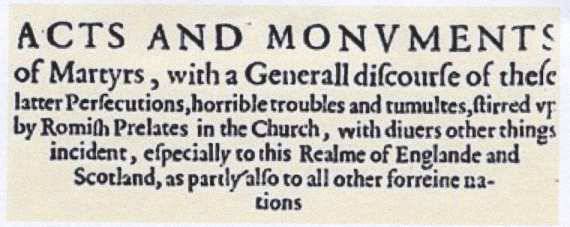In Part I, we looked at the origins of Lollardy in the 1380s with John Wyclif in Oxford and at his radical proposals for a bible in English to provide the ordinary person with direct scriptural authority rather than having to follow blindly the teachings and traditions of the Catholic Church which he argued had become corrupted and unscriptural. Even the Pope should not be obeyed unless warranted by Scripture. Modern Protestants would feel quite at home with his ideas, but they were then condemned as dangerously subversive and heretical.
The main source of information about the Lollards comes from Foxe’s Book of Martyrs, first published in Latin in 1559 and in English in 1563. John Foxe (1517-87) was ordained as an Anglican deacon in 1550 and fled from the Marian persecution of Protestants, spending the five years of Queen Mary’s reign in exile in Basle where he wrote most of the first edition of his great book. He protested against its popular title as ‘the Book of Martyrs’, because it was, in effect, a history of England interlaced with the history of the Christian Church from the earliest days. It included political history, lengthy accounts of events abroad, sermons and letters, theological disputes, anecdotes and jests, all in voluminous detail of over 4 million words, and grew in successive editions in his lifetime, occupying eight bulky volumes in the mid-Victorian edition, illustrated with 170 woodcuts.
His book was received with extravagant admiration and in 1571 it was ordered to be set up in every cathedral and in the houses of church dignitaries. Many parish churches had a copy, so we may well have had a copy in Penn. It was widely read for centuries. He recorded the Lollards and their Protestant successors as glorious martyrs, shining examples for the future. He used official documents and sought out invaluable written or oral testimony of first hand witnesses, including, as we shall see, one from Penn.
He spoke and wrote freely and frankly, showing both courage and industry and an enduring hatred of tyranny and cruelty, but it was hurriedly written and so not always accurate in detail, especially on dates, and was inevitably full of the grotesquely anti-catholic theological prejudices of his time.
© Miles Green, December 2006
1 “Acts and Monuments of Martyrs, with a General discourse of these latter Persecutions, horrible trouble and tumults, stirred up by Romish Prelates in the Church, with diverse other things incident, especially to this Realm of England and Scotland, as partly also to all other foreign nations”

